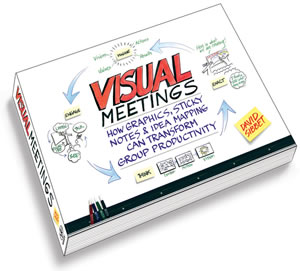 Last week, I received a review copy of David Sibbett’s new book, Visual Meetings: How Graphics, Sticky Notes and Idea Mapping Can Transform Group Productivity. Because I was on the road for 5 days, I had a chance to read the first few chapters of it. My first impression? Very impressive!
Last week, I received a review copy of David Sibbett’s new book, Visual Meetings: How Graphics, Sticky Notes and Idea Mapping Can Transform Group Productivity. Because I was on the road for 5 days, I had a chance to read the first few chapters of it. My first impression? Very impressive!
Sibbett makes a convincing case for why teams ought to use visual techniques for group facilitation. For starters, there is a lot more information today and it’s harder for us to make sense of it (and since the recession caused major layoffs and early retirements, there are fewer of us survivors left to make sense of it!). Also, many of the problems we’re trying to tackle are system-level challenges, which require groups to think bigger picture, or over longer time frames than they are accustomed to doing. In addition, today’s rapid rate of change requires that we update our mental models of how things work on a frequent basis.
Depicting challenges visually can help us in all of these areas. Simply put, visualizing challenges creates a shared frame of reference, builds a higher level of engagement of all group members, and tends to draw forth their best ideas.
Sibbett does a great job of explaining how to get started. While Dan Roam’s book, The Back of the Napkin, presented a framework or visual dictionary of shapes and symbols that we can use to communicate ideas visually, Sibbett goes another level deeper by demonstrating to the reader how to draw a collection of simple shapes – such as points, lines, triangles and squares – and then explains how to draw more complex shapes based on these building blocks.
I’m also impressed that Sibbett outlines some recommended exercises that help to build engagement among group members. Often, people walk into meetings with their own mental models about their roles, their perceptions about the other people in the meeting and their motivations, and what they have been called upon to accomplish. These perceptions often create conflict and get in the way of the group accomplishing its objectives. Some simple visual exercises help everyone to build a sense of shared purpose and trust, and improve their level of engagement in the meeting.
I still have much more to read, but so far I’m really really loving Visual Meetings!

Leave a Reply